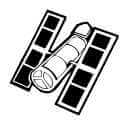Down
| 1. | Any planet's natural satellite. |
| 3. | A relatively small, icy celestial body with a long tail of light that revolves around the sun. |
| 4. | The brightest and sixth largest planet in the Solar System. |
| 5. | Pieces of rock or metal that have reached the Earth from outer space. |
| 7. | That point of a planet's or comet's orbit which is most distant from the sun. |
| 8. | A unit of length equal to the average distance from Earth to the sun (93 million miles). (2 words) |
| 9. | The process by which material is worn away by forces such as glaciers, wind, and waves. |
| 10. | (2 Words) Mercury, Venus, Earth, and Mars. (2 words) |
| 14. | The nine major celestial bodies that orbits the sun. |
| 15. | The point in the orbit of a planet or other body at which it comes closest to the sun. |
| 16. | One complete circular movement made by one object around another object. |
| 17. | This planet is the least dense of any planet. |
| 21. | The amount of physical matter that an object contains, usually measured in grams or ounces. |
|
|
Across
| 2. | The curved path in which a planet, satellite, or spacecraft revolves around another body. |
| 3. | The outer atmosphere of a star. |
| 6. | A straight line through the center of a circle, from one side to another. |
| 11. | This planet has eleven known rings, all of which are very faint. |
| 12. | The only planet whose name is not derived from Greek or Roman mythology. |
| 13. | The sun and the celestial bodies that orbit the sun, including planets, satellites, asteroids, comets, dust, and gas. (2 words) |
| 18. | An imaginary line through the middle of a body or planet, through which that object spins. |
| 19. | A piece of rock or metal from space that enters the earth's atmosphere at high speed and burns up. |
| 20. | (2 Words) Jupiter, Saturn, Uranus, and Neptune. (2 words) |
| 22. | The act of turning on, or around, an axis. On Earth, this is equal to 23 hours, 56 minutes, and 4 seconds. |
| 23. | The use of mathematics facilitated the discovery of this planet. |
| 24. | The nearest star to Earth and the center of the Solar System. |
| 25. | Any of thousands of celestial bodies with diameters between one and five hundred miles that revolve around the sun in orbits located mostly between those of Jupiter and Mars. |
|
































































































































































































































































































































































































































































































































































































































